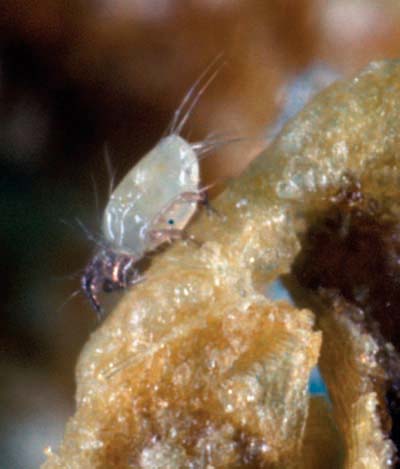
Mold mite, Tyrophagus putrescentiae.
(Photographer: L.J. Buss, University of Florida)
The mold mite is a destructive pest of store products found in materials with a relatively high fat content. Infestations may occur in ham, cheese, flour, herring meal, grain, seeds, bulbs, straw, dried fruits and nuts, cereal foods, mushrooms, copra, bird and small mammal nests, etc. Mold mites are very common but usually go unnoticed except on occasions when they become abundant, then they can cause tremendous losses. Mold mites only develop where there is moisture or high humidity. They feed on molds and are common only where mold and fungi can flourish. This species is worldwide in distribution.
This mite and several others species of mites can cause an allergic disorder (sometimes called “grocer’s itch”) among bakers and food industrial workers, and among residents in agricultural environments. Residents of urban areas who keep large quantities of its hosts (such as rice) in storage may also be afflicted.
The mite is very small, about 0.28 to 0.41 mm long, with males smaller than females. It is translucent and more slender than other mites. Its life cycle can be as short as two to three weeks at optimum temperature and humidity.
T. putrescentiae is not the only species of mite that lives on mold on stored products. Many of these other species have habits similar to T. putrescentiae.
Images
To save the Web-optimized images shown below to your hard drive:
|
Click to access Display and Print quality images. |
|
Click to access Display and Print quality images. |